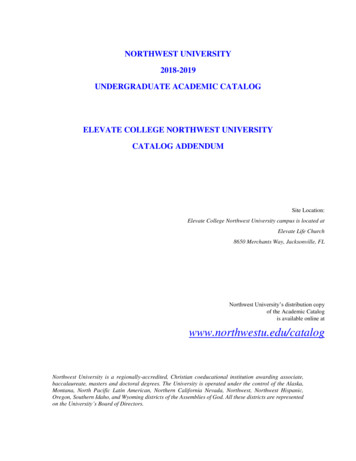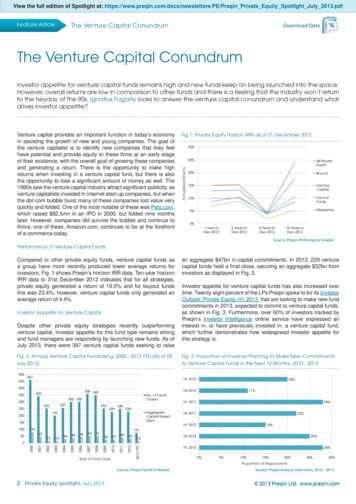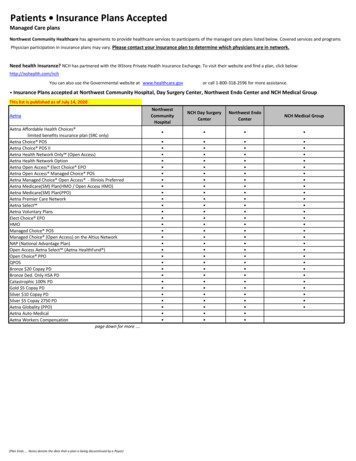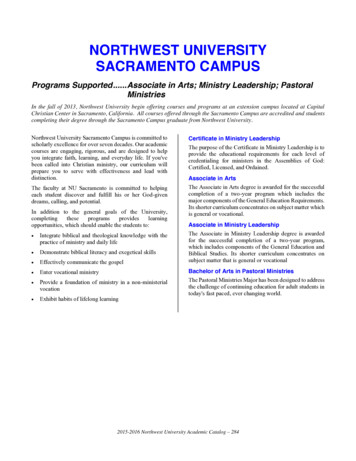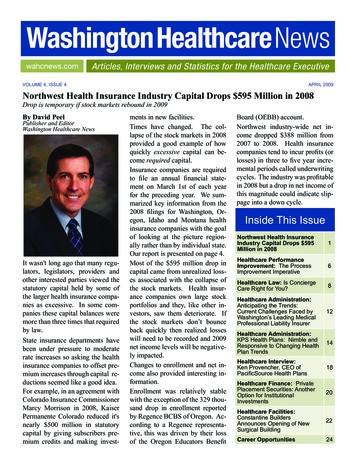
Transcription
APRIL 2009VOLUME 4, ISSUE 4Northwest Health Insurance Industry Capital Drops 595 Million in 2008Drop is temporary if stock markets rebound in 2009By David PeelPublisher and EditorWashington Healthcare NewsIt wasn't long ago that many regulators, legislators, providers andother interested parties viewed thestatutory capital held by some ofthe larger health insurance companies as excessive. In some companies these capital balances weremore than three times that requiredby law.State insurance departments havebeen under pressure to moderaterate increases so asking the healthinsurance companies to offset premium increases through capital reductions seemed like a good idea.For example, in an agreement withColorado Insurance CommissionerMarcy Morrison in 2008, KaiserPermanente Colorado reduced it'snearly 500 million in statutorycapital by giving subscribers premium credits and making invest-ments in new facilities.Times have changed. The collapse of the stock markets in 2008provided a good example of howquickly excessive capital can become required capital.Insurance companies are requiredto file an annual financial statement on March 1st of each yearfor the preceding year. We summarized key information from the2008 filings for Washington, Oregon, Idaho and Montana healthinsurance companies with the goalof looking at the picture regionally rather than by individual state.Our report is presented on page 4.Most of the 595 million drop incapital came from unrealized losses associated with the collapse ofthe stock markets. Health insurance companies own large stockportfolios and they, like other investors, saw them deteriorate. Ifthe stock markets don’t bounceback quickly then realized losseswill need to be recorded and 2009net income levels will be negatively impacted.Changes to enrollment and net income also provided interesting information.Enrollment was relatively stablewith the exception of the 329 thousand drop in enrollment reportedby Regence BCBS of Oregon. According to a Regence representative, this was driven by their lossof the Oregon Educators BenefitBoard (OEBB) account.Northwest industry-wide net income dropped 388 million from2007 to 2008. Health insurancecompanies tend to incur profits (orlosses) in three to five year incremental periods called underwritingcycles. The industry was profitablein 2008 but a drop in net income ofthis magnitude could indicate slippage into a down cycle.Inside This IssueNorthwest Health InsuranceIndustry Capital Drops 595Million in 20081Healthcare PerformanceImprovement: The ProcessImprovement Imperative6Healthcare Law: Is ConciergeCare Right for You?8Healthcare Administration:Anticipating the Trends:Current Challenges Faced byWashington’s Leading MedicalProfessional Liability Insurer12Healthcare Administration:KPS Health Plans: Nimble andResponsive to Changing HealthPlan Trends14Healthcare Interview:Ken Provencher, CEO ofPacificSource Health Plans18Healthcare Finance: PrivatePlacement Securities: AnotherOption for InstitutionalInvestments20Healthcare Facilities:Constantine BuildersAnnounces Opening of NewSurgical Building22Career Opportunities24
Letter from the Publisher and EditorPublisher and EditorDavid PeelContributing EditorNora HaileContributing WriterRoberta GreenwoodBusiness Address631 8th AvenueKirkland, WA 98033Contact InformationPhone: 425-577-1334Fax:425-242-0452E-mail: dpeel@wahcnews.comWeb: wahcnews.comTO GET YOUR COPYIf you would like to be added tothe distribution, go to our web siteat www.wahcnews.com, click onthe “subscribe” tab at the top ofthe page and enter all informationrequested. Be sure to let us knowwhether you want the hard copyor the web version.LETTERS TO THE EDITORIf you have questions or suggestions regarding the Newsand its contents, please reply todpeel@wahcnews.com.Dear Reader,Each month we call hundreds of recruiters at northwest health care organizations to ask if they wouldlike to advertise their open positions with the Washington Healthcare News. It’s a great way to connect and gain first hand knowledge of the currenthiring environment.Over the last few months we’ve seen severalchanges related to our niche: helping health care organizations recruitmanager and higher level staff. Some organizations have implementedhiring freezes while others have reduced recruiting budgets.Revenues are flat at many health care organizations However, clinicand hospital utilization activity has either increased or gone down onlyslightly. Managers must still be hired and here are a few suggestions touse your recruiting dollars wisely. Recruit regionally. Go beyond your backyard. Good health caremanagers are scarce and a lone web site posting won’t attract themost qualified applicants. Target your recruiting to health care specific networks, associationsand publications. If you aren’t currently hiring then redirect your recruiting budgetto market your organization to employees you’ll need in the future.This is very important if you’re located in a regional or rural area.In this difficult business environment it is important to bring on the bestmanager and higher level staff available. This requires a reasonable investment in up-front recruiting costs and a solid strategy to carry it out.David Peel, Publisher and EditorWashington Healthcare News 2009 Editorial CalendarMonth and YearTheme of EditionSpace ReservationDistribution DateJanuary 2009Urban Medical ClinicsDecember 1, 2008December 22, 2008February 2009Human ResourcesJanuary 2, 2009January 19, 2009March 2009Rural HospitalsFebruary 2, 2009February 23, 2009April 2009Insurance CarriersMarch 2, 2009March 23, 2009May 2009Information TechnologyApril 1, 2009April 20, 2009June 2009Rural Medical ClinicsMay 1, 2009May 25, 2009July 2009FacilitiesJune 1, 2009June 22, 2009August 2009Human ResourcesJuly 3, 2009July 20, 2009September 2009FinanceAugust 3, 2009August 24, 2009October 2009Community Health CentersSeptember 1, 2009September 22, 2009November 2009Urban Medical ClinicsOctober 1, 2009October 19, 2009December 2009Urban HospitalsNovember 2, 2009November 23, 2009-2-
Consultant MarketplaceParticipating CompaniesBonnie Jasman Cech, MHSAPresidentCech Systems, Inc.Participating Company, Consultant MarketplaceThe Consultant Marketplace,located on the WashingtonHealthcare News web site, iswhere over 60 companies thatspecialize in providing services orproducts to health careorganizations are found.When using external firms, doesn’tit make sense to use those thatspecialize in health care?Visit wahcnews.com/consultantto learn how these companies canhelp make your business moreefficient and effective.631 8th Avenue, Kirkland, WA 98033 425-577-1334 wahcnews.comAdaptisAmerinet/HRSAter Wynne LLPBennett Bigelow & Leedom, P.S.Bernard HODES GroupCarris Technology SolutionsCech Systems, Inc.Cicotte Law Firm LLCCIDA, Inc.COBRA Management Services, LLCConstantine Builders, Inc. (CBI)Cottle & Swanson, CPA’s, PLLCDeering & AssociatesDerry, Nolan & Associates, LLCE-MEDEXEvergreen ReEvosus SolutionsFCG BenefitsFinancial Consultants of Alaska & WashingtonFirst Choice HealthGarvey Schubert BarerGreat Northern Staff AdministratorsGrubb & EllisHansten Healthcare PLLCHealth Business NavigatorsHealthcare Management Administrators (HMA)Healthcare Resource GroupHealthFirst Financial (HFF)I.C. System, Inc.InteliusInvisible CareGiver Innovations, LLCJCW, Inc. Commercial Contractor/DeveloperKaye-SmithKPS Health PlansMedRisk, LLCMEIER Enterprises, Inc.Miller Nash LLPMoss Adams LLPnhaile solutions, llcNorthwest Credentials Verification Services (NCVS)Noyes & Associates, Ltd.Pathway2Design Healthcare Solutions GroupPaul Goldberg & Associates, LLCPrime Advisors, Inc.Professional Credit Services (PCS)Red Cedar Partners, LLCSCP Inc.Spectrum Information Services NW, Inc.Stoel Rives LLPStrategic Opportunity SolutionTaylor Gregory Butterfield ArchitectsThe Champion Healthcare Consulting Group, LLCThe Management TrustThe Washington Healthcare NewsTIAA/CREFTransitions TeamTransworld SystemsUBC, Inc.Washington Archives ManagementWashington Imaging Services, LLCWilliams KastnerWitherspoon Kelley Davenport & Toole, P.S.
468782ORKaiser Foundation HP of the NW777449206IDBlue Cross of ID Health Service205139WAMTIDWAORWACommunity Health Plan of WABlue Cross Blue Shield of MTRegence BlueShield of IDGroup Health OptionsPacificSource Health PlansPacifiCare of WA2ORORTrillium Health PlanFamilyCare Health -102-5-66-329Change 2,282,452 14,076 26,235 31,416 0 32,437 65,810 74,223 150,899 149,570 170,369 177,676 158,279 320,178 305,944 386,681 470,824 470,039 386,853 423,866 508,999 521,334 652,790 809,441 969,018 2,242,125 2,214,887 2,208,390 2,489,848 19,497,727 18,714,659 20,408 29,681 32,512 43,482 46,691 67,352 84,545 154,014 182,592 195,235 206,941 230,338 267,715 273,933 421,387 429,210 479,829 481,404 508,110 516,240 533,495 709,310 894,251 999,804 1,939,292 2,281,263 2,320,950 2,552,0892007Total Revenues 2,595,6542008 783,068 6,332 3,446 1,096 43,482 14,254 1,542 10,322 3,115 33,022 24,866 29,265 72,059- 52,463- 32,011 34,706- 41,614 9,790 94,551 84,244 7,241 12,161 56,520 84,810 30,786- 302,833 66,376 112,560 62,241 313,202Change 193,494- 235 33- 31- 647 834 10,250 3,501- 3,488 1,329- 2,119 5,692 3,976- 9,953 29,245 3,838 45,816- 3,601- 1,236- 10,620 17,687- 4,260 40,397- 2,142 17,274- 24,350- 16,312 32,592 34,930 25,0942008 581,900 731 586 1- 3,620 56 1,505- 2,281- 2,557 3,538 5,787 1,149 4,598- 5,274 21,376 12,098 54,016 9,901 143- 902 21,220 5,548 45,477 58,468 33,794 64,175 66,598 59,041 105,876 20,8522007Net Income- 388,406- 966- 553- 32 2,973 778 8,745 5,782- 931- 2,209- 7,906 4,543- 622- 4,679 7,869- 8,260- 8,200- 13,502- 1,379- 9,718- 3,533- 9,808- 5,080- 60,610- 16,520- 88,525- 82,910- 26,449- 70,946 4,242Change-4- 4,318 4,712 2,959 3,405 6,490 29,105 11,098 17,327 39,846 32,796 37,283 30,667 58,819 44,885 57,423 249,555 93,239 29,968 108,358 118,010 63,431 94,621 343,050 259,548 550,235 797,173 480,100 672,236 486,293 5,322,112 4,209 4,122 2,985 3,839 4,313 20,347 7,595 21,667 38,281 34,190 31,403 21,319 69,922 46,677 67,436 228,602 124,500 31,707 125,571 144,987 77,583 113,622 340,520 260,890 737,754 925,463 494,196 784,031 554,3812007- 595,162 109 590- 26- 434 2,177 8,758 3,503- 4,340 1,565- 1,394 5,880 9,348- 11,103- 1,792- 10,013 20,953- 31,261- 1,739- 17,213- 26,977- 14,152- 19,001 2,530- 1,342- 187,519- 128,290- 14,096- 111,795- 68,088ChangeY/E Statutory Capital2008 4,726,950Source: Five-year Historical Data page of the 2008 NAIC Annual Statement compiled by the Washington Healthcare News - wahcnews.com.Total All Insurance Companies15IDPrimary Health Network, Inc.45ORWA538Puget Sound Health PartnersORCareOregon43872582Samaritan Health PlansWAColumbia United Providers60ORWAAsuris Northwest HealthWAWALifeWise Health Plan of WAODS Health PlanWAArcadian Health PlanKPS Health Plans79ORLifeWise Health Plan of OR29PacifiCare of OR123ORORHealth Net Health Plan of OR45136226247299ORWAProvidence Health PlanMolina Healthcare of WA388WAWARegence BlueShieldGroup Health Cooperative664ORWA2008Regence BCBS of ORStatePremera Blue CrossInsurance CompanyCalendar Year Ended 2008 versus 2007ID, MT, OR and WA Domestic Carriers (000’s omitted)Health Insurance Company Financial Results
Marcy Shimada, Executive DirectorPuget Sound Family Physicians andEdmonds Family Medicine Clinic, PS,Edmonds, WA“Physicians Insurance has been responsive to ourdesire to have active risk management. They bringus ideas and programs that we can make our own.It has been beneficial to have PI challenge us todemonstrate our systems for follow-up.”Every physician needs a good foundation. www.phyins.comSeattle, WA ( 206) 343-7300 or 1-800-962-1399 . Spokane, WA (509 ) 456-5868 or 1-800-962-1398Endorsed by the Washington State Medical Association
Healthcare Performance ImprovementApril 2009 wahcnews.comThe Process Improvement ImperativeBy Bonnie Jasman Cech, MHSAPresidentCech Systems, Inc.in leadership. This shift in focusis neither easy nor quick, but thelong term benefits are well-worththe investment. Using lean principles as a foundation, healthcareorganizations can do somethingthat matters right now: implementimprovement in their core business processes and move towardsa more efficient overall deliverysystem.Specify value from the patient’sperspectiveNowhere in our society is processimprovement needed more thanin health care. Growing at an annual rate over 6%, health carecosts are outpacing inflation andwages. The media is focusing alot of attention on inadequate access, service delays, error ratesand less-than optimal outcomes,but significant labor shortages andcare-giver burnout (including physicians) also threaten quality. Atthe same time, baby boomers growolder, the elderly live longer, andthe prevalence of chronic diseaseincreases; the industry faces significant increases in demand butlimited resources to manage it.While there is no panacea for allthat ails the healthcare system,physician groups and hospitalscan achieve dramatic improvements in efficiency, quality, andsatisfaction by embracing systemlevel process improvement. Successful implementation requires achange in methods -- and a changeLean process improvement can bedescribed as the least wasteful wayto provide value to your patients.The critical starting point then is tounderstand value, not as we havetraditionally defined and measuredit in healthcare organizations (e.g.,revenue centers, asset optimization, technologies), but as specified from the patient’s (customer’s)perspective.they begin to clearly focus on aservice line, and ways to increasethe value of that service for the patient.Streamline primary patientpathways end-to-endAs we shift our thinking fromfunctions or departments to service lines, it enables us to definethe primary value streams withinthe core business. Through theprocess of mapping the valuestreams, we can begin to see clearly the individual steps of the process from beginning to end. Witha clear view of each step, we areready to streamline the process –to eliminate the hidden waste andimprove the flow of value to thepatient.The key to streamlining your corebusiness processes is to involveand engage the people providingthe service - the physicians andfront-line staff. Armed with theproper tools, techniques and training, they become your improvement experts to identify, quantify,and eliminate waste in their processes.How do you find out what patientsvalue? Ask them. Conduct focusgroups or interviews with patientsand ask targeted questions aimedat understanding the underlying(emotional) attributes they ascribeto the value of your services. If Core business process improveyour budget doesn’t allow for a ment - specifying value from theformal interview process, start patient’s perspective and streamwith the patient feedback informa- lining patient pathways - is antion you already obtain through enlightening experience. Notpatient satisfaction surveys, pa- only is there clear benefit to thetient complaint reports and patient patient (e.g., better access, fewersuggestion systems. Categorize service delays, quicker responseand quantify the information to be- to requests, higher quality), butgin understanding value. It’s only the organization benefits as well.when healthcare organizations Physicians and staff experiencefundamentallyrethink value fromVisit wahcnews.comfor current career opportunitiesthe perspective of the patient that Please see Improvement, P10-6-
Count onour healthcarelaw solutions.Your healthcare business operates in a complex environment. Miller Nash’steam of healthcare attorneys has the specialized knowledge and depth ofexperience to help successfully navigate the constantly changing issues andchallenges you face.Please contact: Bob Walerius bob.walerius@millernash.comSpecializing in: Regulatory Compliance Board Governance Physician Credentialing Fair Hearings Labor and Employment Joint Ventures Physician Recruitment & Contracting Real Estate206.622.8484
Healthcare LawWashington Healthcare News April 2009 wahcnews.comIs Concierge Care Right for You?By Leslie M. MeseroleHealthcare Attorney and PartnerMiller Nash LLPPrimary care physicians are declining in number, largely becauseof heavy patient loads, poor reimbursement levels, and insufficienttime for properly evaluating patients. One option for physicianswishing to continue practicingin primary care is to reform theirpractices into what is known as"concierge care." The underlying philosophy of concierge careis that of a “membership practice”in which patients pay an annualfee in exchange for enhanced physician services, such as same dayappointments, longer appointmenttimes, 24-hour telephone access tophysicians and coordinated referrals to specialists. Physicians maylimit the number of patients in thepractice, self-regulate the timespent with each patient, and determine the membership fee amountcharged independent of payor reimbursement rates.Utopia in primary care? Soundslike the ideal practice, right? Notso fast! Concierge care's growtharound the country has promptedscrutiny under the watchful eyesof Medicare, the Office of Inspector General (the "OIG"), and various state government agencies, including the Washington Office ofthe Insurance Commissioner (the"OIC"), resulting in new guidance,rules, and state law.Medicare and the OIG. In March2002, Medicare published guidance on concierge care in general,stating that concierge care membership fees collected from Medicare beneficiaries may constituteprohibited charges if those chargesare for services already covered byMedicare. In addition, the OIG issued an Alert in March of 2004,stating that “when participatingproviders request any other payment for covered services fromMedicare patients they are liablefor substantial penalties and exclusion from Medicare and other federal healthcare programs.” In other words, participating physicianswho charge Medicare enrollees forservices already covered by Medicare, other than the applicable deductible and coinsurance amounts,are violating the physician’s assignment agreement, in whichthe physician agrees to accept theMedicare fee schedule amount forall covered services provided toMedicare beneficiaries. Non-participating providers must also observe this guidance, because eventhough non-participating providers do not accept the Medicare feeschedule amount as payment in fullfor covered services, they are stilllimited as to the amount they maycharge Medicare beneficiaries.They really mean it! In 2003 and2007, the OIG entered into settle-8-ment agreements with physiciansoperating concierge practices onthe basis that the physicians hadovercharged beneficiaries in violation of the physicians’ assignmentagreements. The OIG asserted thatthe physicians had charged Medicare beneficiaries a membershipfee for services already coveredand reimbursable by Medicare.The settlement agreements, however, did not specify which services were covered. The result: acompliance challenge and a desirefor more clear-cut guidance.Opting out is an alternative. Tosteer clear of these overpaymentissues, physicians may opt out ofMedicare altogether by agreeingto not submit for two years claimsfor reimbursement of any servicesprovided to Medicare beneficiaries. By opting out, physiciansare not limited in what they maycharge concierge care patients forservices, whether or not the services are covered by Medicare.What’s all this talk about insurance? In 2007, the WashingtonOIC published an opinion in support of proposed concierge carelegislation stating that providerswho practice concierge care assume risk by accepting prepayment for an unknown amount ortype of services, and are thereforeconsidered health care service contractors subject to OIC regulation.However, the OIC went on to saythat given the limited amount ofrisk and potential harm to consumers, the full scope of regulation isnot practical or warranted. In theend, the Washington legislaturePlease see Concierge, P11
Because.It’s Rocket Science(or at least it feels that way.)Selecting a health plan for your small businessshouldn’t take a PhD in physics. Introducing “Solutions”new small group coverage from KPS Health Plansthat makes taking care of your employees easier thanlaunching a Saturn V rocket from your garage.4 Easy-to-follow plan designs4 Competitive rates4 Preventive care emphasis4 100% coverage after office visit copay4 On the job coverage for owners and officers4 All plans include pharmacy coverageAnd, with KPS’s network of providers, including morethan 47,000 in Washington state alone, you know youwill be covered wherever life takes you. Contact yourbroker or KPS directly for more information.Blast Off!There’swww.kpshealthplans.com 360 478-6786 800 628-3753
Improvement, from P6increased satisfaction with theirwork, while at the same time increasing throughput, productivity,and overall profitability.Identify organizational changeneeded to sustain improvementThe activities outlined previously require new methods (such astechniques for specifying value,mapping value streams, definingand eliminating waste). The thirdactivity, identifying the changesneeded to sustain improvement, requires new leadership. It involvesrethinking organizational behaviorand development, plus management systems and structures. Itinvolves rethinking the traditionalroles of department managers, forexample, and introducing the concept of value stream managers. Itinvolves the design of new systems to manage the improvementprocess itself, to monitor the valueWe hate lawsuits. We loathe litigationWe help doctors head off claims at thepass. We track new treatments andanalyze medical advances. We are theeyes in the back of your head. Wemake CME easy, free, and online. Wedo extra homework. We protect goodmedicine. We are your guardian angels.We are The Doctors Company.The Doctors Company is devoted to helping doctors avoid potentiallawsuits. For us, this starts with patient safety. In fact, we have thelargest Department of Patient Safety/Risk Management of anymedical malpractice insurer. And, local physician advisory boardsacross the country. Why do we go this far? Because sometimes thebest way to look out for the doctor is to start with the patient. To learnmore about our medical professional liability program, call our Seattleoffice at (877) 673-2101 or visit us at www.thedoctors.com.A2614 WAHealthcardNews.indd 1-10-3/2/09 4:24:27 PMstreams, and to ensure that theimprovement efforts are linkedto the over arching strategy anddirection of the organization. Itinvolves rethinking the flow ofinformation throughout the organization, and how this knowledgeflows to the people closest to thework - the physicians, clinicalstaff, schedulers and receptionists performing the core businessprocesses. In other words, it requires the organization to developthe capacity to keep the primarypatient pathways clear and ensure improvement results are sustained.SummaryWhile the healthcare industryfaces its share of challenges, corebusiness process improvementprovides an exciting opportunityfor healthcare organizations toenhance their competitive position and ongoing ability to thrive.Just as important, continuingdedication to finding better waysto produce value-added servicesis what our industry needs nowmore than ever.Bonnie Jasman Cech, MHSA isthe President of Cech Systems,Inc. where she has developedan innovative systems approachto applying lean principles.Through CxInSight, Cech Systems, Inc. helps medical organizations implement resultsdriven process improvements,supportive management systems(tools and metrics), and effective training programs to sustainthe improvement results. Bonniecan be reached at 206 524-7710or bcech@cechsystems.com. Tolearn more about Cech Systemsor CxInSight, visit the web siteat www.cechsystems.com.
Volume 4, Issue 4charged more than the membership fee for the primarycare services. Concierge carephysicians may bill insurancecarriers and patients for services provided outside the scopeof the primary care servicesdescribed in the written agreement with the patient. Concierge, from P8approved legislation codified atRCW 48.150, adopting rules forthe operation of concierge carepractices.Washington law. Those physicians who decide that conciergecare is their desired form of practice should carefully consult theWashington statute; failure tocomply constitutes unprofessionalconduct enforceable under RCW18.130.180. These requirementsinclude: Concierge care physicians mayprovide only primary care services, as defined in the statute,in exchange for the membership fee by entering into a written agreement with patientsthat must describe the servicesto be provided and be terminable at will by the patient. Insurance carriers may not bebilled and patients may not be The membership fee must becharged to patients monthlyand may not be increased morefrequently than annually. The concierge care practicemay not accept or declinepatients based on health status, race, religion, disability,education, economic status,or sexual orientation, and themembership fee may not varybased on health status or sex.Focus on the future. Both CMSand the Washington state government are monitoring conciergecare. Washington concierge care-11-practices must submit annual reports to the OIC. In December2012, the OIC will submit a studyto the legislature analyzing whether concierge care improves or reduces access to care, increasesconsumer costs, and provides adequate consumer protection. CMShas implemented an agency wideeffort to monitor Medicare beneficiaries’ access to care, including afocus by the Seattle regional officeon the impact of concierge care onaccess to care. The future promises evolving regulation, whichmandates careful attention to compliance.Leslie M. Meserole is a healthcareattorney and partner at MillerNash LLP. She can be reached atleslie.meserole@millernash.com.Miller Nash LLP is a multispecialty law firm with offices in Seattleand Vancouver Washington, andPortland and Central Oregon.
Healthcare AdministrationWashington Healthcare News April 2009 wahcnews.comAnticipating the Trends: Current Challenges We Face as the State’s LeadingMedical Professional Liability InsurerBy Susan Peskura, CPCU, RPLUAssociate Vice President,Marketing & SalesPhysicians InsuranceA Mutual CompanyNo one says it’s easy being on top.Physicians Insurance A MutualCompany insures more physiciansthan any other insurance carrier inWashington. Having physicianscontinue to entrust their coverageto us requires diligence in understanding health care delivery andcontrolling claim costs with practical and effective risk managementtools and patient safety programs.It also requires a conservative approach to managing our investment portfolio. And to stay on top,the company must provide industry-leading customer service.2009 premiumsIn 2009, thanks to a decline inclaim frequency, our member insureds received a 10% decrease inpremium rates while continuing tobe eligible for our ACCOLADESloss experience credits, which canreduce premium by another 5%up to 20% for members with excellent loss histories. In 2008, thecompany was also able to returndividends to its members totaling 5,000,000.Cautious reserve managementPhysicians Insurance manages itsassets conservatively. While otherfinancial services organizationssuffered weighty blows due toinvestment in derivatives or otherwise risky securities, more than90% of our company’s assets areplaced in a highly rated and welldiversified bond portfolio. Therest is invested in equity mutualfunds and short-term investments.This conventional approach to asset management resulted in positive returns on investments andcontrasted significantly to overallindices, which were down significantly in 2008.Risk management and patientsafety initiativesOur focus in risk management andpatient safety education lies inaugmenting providers’ own practice standards with good patientcommunications skills-buildingprograms, practice safety audits,and patient record-keeping tools.Our new AVERT (AdVerse EventResponse Team) training programincorporates enhanced physician/patient communications skillsbuilding training. It also promotesa patient-focused approach to adverse outcome management. We’realso launching Patient SAFE (Patient Safety Assessment for Ev-12-ery Medical Practice), an auditingmechanism clinics can implementto regularly evaluate their patientsafety practices. Patient SAFEuses ten parameters for assessingquality care, including maintainingdetailed medical records, securinginformed consent, and recording known allergies. These riskmanagement programs, as wellas numerous Continuing MedicalEducation courses we provide forour members, are designed to helpphysicians achieve their professional goal of outstanding patientsafety while also lessening the frequency and severity of claims.Regulatory reporting dutiesChallenges facing both insurersand self-insured organizations aretheir regulatory reporting duties.For many years, payers of medicalprofessional liability claims havereported those payments to the National Practitioner Data Bank andthe Medical Quality AssuranceCommission. Last year, all payersof medical professional liabilityclaims began reporting outcomesto the Washington Insurance Department. This year, the Center forMedicare and Medicaid Services(CMS) is requiring all liabilityinsurers and self-insured organizations that pay liability claimsto register with CMS and reportall their claim payments made toMedicare beneficiaries. Additionally, both insurers and self-insuredorganizations have a responsibility to assure that their physiciansPlease see Trends, P16
EVERYONE BENEFITSFROM SOUND LEGAL ADVICEOUR BREADTH OF EXPERIENCE keeps our clients focuse
KPS Health Plans: Nimble and Responsive to Changing Health Plan Trends 14 Healthcare Interview: Ken Provencher, CEO of PacificSource Health Plans 18 Healthcare Finance: Private Placement Securities: Another Option for Institutional Investments 20 Healthcare Facilities: Constantine Builders Announces Opening of New Surgical Building 22
